A Fish Eat Fish World - Bass Flies Pt. 2
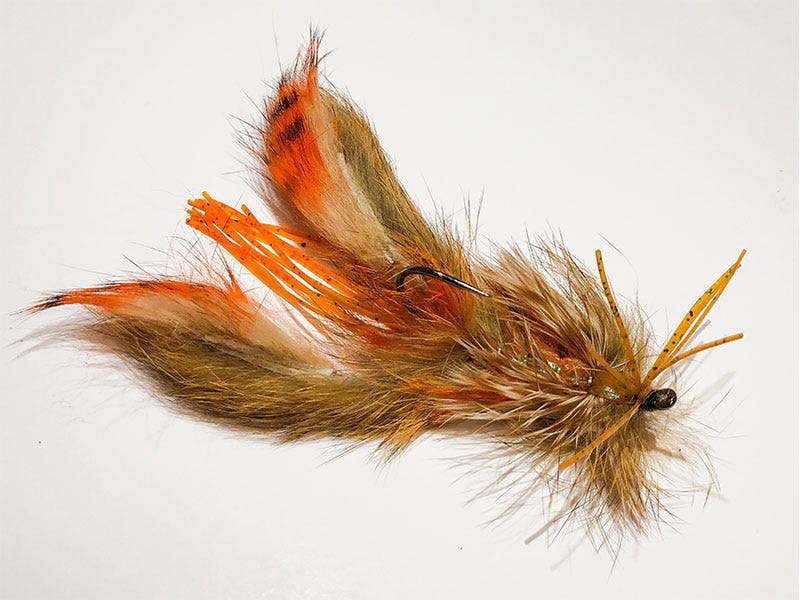
By Mike Schultz and Taylor Hess
Mike Schultz of Schultz Outfitters knows a thing or two about smallmouth and how to catch them. To Schultz, being versatile through the water column starts on the vise. (Schultz Outfitters fish water around the great lakes region and their flies reflect forage of the Midwest.) So, for Schultz, being able to match flies to forage based on a singular platform is important.
In case you missed it, Gunnar Brammer explains his fly choices in, A Fish Eat Fish World Pt. 1
Schultz also suggests that understanding where you want to fish your flies in relation to the water column is just as important.
“We tend to focus a lot on tying one particular pattern one particular way. Changing weight loads, hooks, and minor material changes can make a huge difference. Having a dynamic selection of flies that can be fished in any situation gives you the advantage over the fish. It’s important to note that smallmouth patterns change dramatically over the course of the year. Transitions from pre-spawn through post-spawn, summer patterns, the fall bite, and wintering holes all dictate what fly type you will fish. Variations of patterns can take your fly box to the next level.”
Want to take your fly box to the next level? Order fly tying materials online here.
Mike classifies two types of subsurface flies in his arsenal— dredgers and swim flies. On both levels, these flies can be easily tweaked to imitate different forage.
Dredgers
Dredgers are crucial certain times of the year when getting down to fish is a must. Flies such as Schultz’s red eye leech, S3, and single fly cray all imitate deep water column forage. Heavy flies easily dive to the bottom where bass may be lying in wait to ambush prey. These flies are best when the fish are still lethargic in the winter or before water temperatures seduce them to suspend in the mid-water column. Variations of these patterns can be tied in just about any color, but Schultz prefers the patterns in natural colors, such as tan, olive, brown, and black. The overall platforms of these flies utilize rabbit strip tails, rabbit strip and/or schlappen bodies, and heavy dumbbell eyes.
Single Fly Cray
- Hook: Ahrex TP650 bent streamer size 1 – 2/0
- Eye: Painted lead eye sized L or XL
- Extra Weight: Tungsten bead in addition to the dumbbell eye
- Legs: Olive or brown orange hot tipped rubber legs 4 to 5 doubled over
- Hot Spot/ Spreader: Rabbit clipped and spun
- Claws: Rabbit strip or possum strips tapered with rabbit strip accents adhered with tear mender
- Shell Back: 5-6 rubber legs ribbed with 16 lb. mono or size medium ultra-wire
- Body: Rabbit strip trimmed and spun in dubbing loop
- Collar: Mallard flank or hen saddle
- Head/ Tail: Rabbit Trimmed and spun in dubbing loop

Schultz adds, “crayfish are a favorite food source of Smallmouth bass, some might say it’s their favorite meal. The SFC has been my go-to cray pattern for many years. Over the past few we’ve fished this fly year-round. Even in near freezing temps this pattern shines. Like all of my “dredger/ jig” patterns, I tie it in a variety of weights and lengths. Medium – XL dumbbell eyes are used in combination with tungsten beads. Think JIG!”
Red Eyed Leech
- Hook: Ahrex TP650 bent streamer sized 1 – 2/0
- Eye: Painted lead eye sized L or XL
- Extra Weight: Tungsten bead in addition to the dumbbell eye
- Tail: Rabbit strip
- Body: Rabbit strip wrapped
- Flash: Optional red and gold or copper Hedron flashabou
- Collar: Mallard flank
- Head: Rabbit strip trimmed off hide and spun in dubbing loop
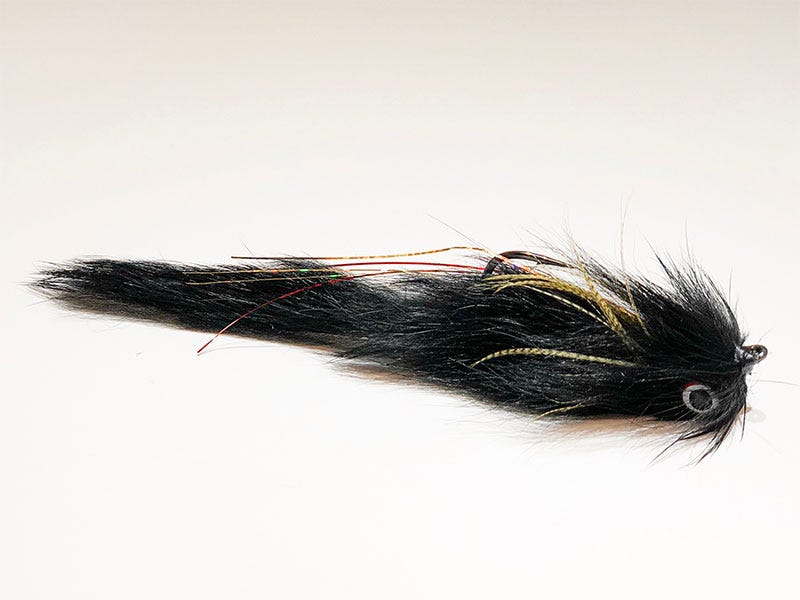
Schultz continues, “the red eyed leech is an extremely simple yet highly effective pattern that I’ve relied on for nearly 20 years. If you’re having a tough day, tie on the red eye and fish with confidence. Just like the SF cray and the S3 sculpin, I tie it in 3-5 different weights. Flash and no flash… fill your box and fish it… you will be rewarded.”
S3 Sculpin
- Hook: Ahrex TP650 bent streamer sized 1 – 2/0
- Eye: Painted lead eye sized L or XL
- Extra Weight: Tungsten bead in addition to the dumbbell eye
- Tail: Rabbit strip with shorter contrasting, rabbit strip adhered with tear mender
- Body 1: Rabbit strip wrapped or clipped and spun in dubbin loop
- Body 2: Contrasting rabbit strip wrapped or clipped and spun in dubbin loop
- Collar: Mallard flank or hen saddle
- Legs: Two sets of rubber legs tied off each side
- Pec Fins: Rabbit strip tied off the sides, tapered tips facing back with grizzly marabou over top
- Flash: Optional red and gold or copper Hedron flashabou
- Head: Rabbit strip trimmed off the hide and spun in dubbin loop
- Wings/ Accent: Two rooster feathers tied on top
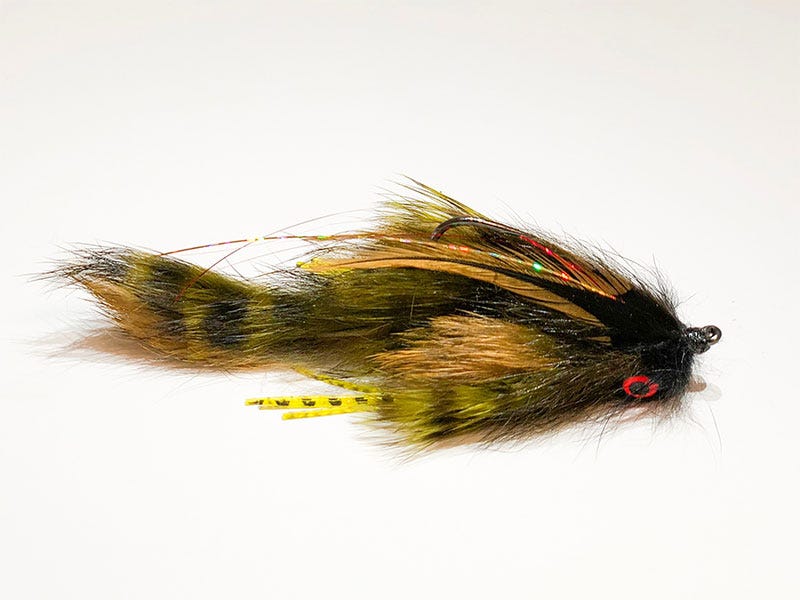
Schultz, “the S3 is built on the same platform as the SF Cray and red eyed leech. Sculpin are a common food source on all of our watersheds. This pattern doubles as a goby. Tie it in natural colors and fish with confidence. Tan, brown, ginger, olive, black, etc.
Swim Flies
There’s a large misconception when it comes to fly-fishing large streamer patterns. Some look at large bass flies and are startled at how large they are. Schultz often ties and soaks patterns in the 5 to 7-inch range. These patterns are no more different than the 5 to 7-inch baits used on conventional gear. Some of Schultz’s favorite swim flies are versatile patterns that can be swung, stripped, and in some cases, even dead drifted with a pop of the rod tip through the drift. Tying swim flies on larger hooks affords the space for a few or more wraps of lead wire for extra weight and as a keel; something Schultz does when out on the river to adjust to different water depths.
Along with versatility on the water, these swim flies follow basic platforms, which can have various materials added to increase their effectiveness in specific situations. A great swim fly is Schultz’s Swingin’ D, a personal favorite. The fly incorporates a lot of materials, but these materials add to the swim motion and opportunity to swap out colors and substitute materials to tweak it easily. The articulations of this pattern help the fly to swim similarly to a swimbait, which is a very realistic motion. It is important to not over-bulk your articulations.
Why tie flies? Store bought versus your own. Read here.
Original Swingin’ D – 4 ½” to 5”
- Rear Hook: Ahrex Gammarus NS172 or partridge Attitude Extra size 4
- Tail: Quality saddle hackle with grizzly accent feathers
- Flash: Hedron flashabou of choice rear body 1 / fill - Senyo’s predator wrap, wrapped and trimmed
- Rear Body 2 / Collar: Rabbit trimmed from hide and spun in dubbin loop
- Wing / Cap: Mallard flank
- Connection: 40 lb. Rio wire bite with 3 beads
- Front Hook: Gamakatsu worm 2/0
- Front Body 1: Rabbit strip wrapped or trimmed from hide and spun in dubbin loop
- Rattle: 5mm glass
- Front Body 2 / Fill: Senyo’s predator wrap, wrapped over rattle and trimmed
- Collar: Marabou
- Accents: Two grizzly feathers, one down each side
- Flash: Hedron flashabou
- Throat: Cascade crest mirror wrap
- Head: Rainey’s size small silver head
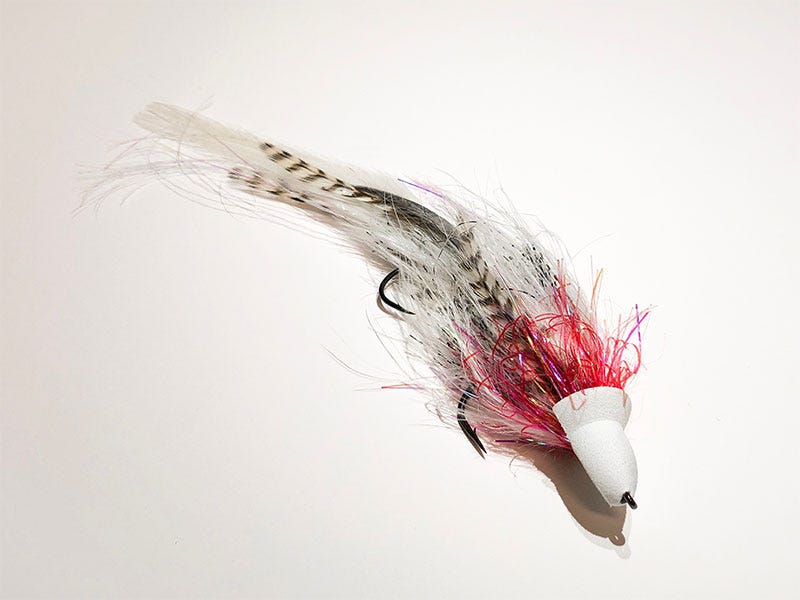
Schultz, “I consider the Swingin’ D my best fly design. This purpose-built fly was instrumental in the progression of my home water programs. Originally tied to fish over wood on my home waters of the Huron River the OG Swingin’ D was just the beginning… Over the years we have tweaked and tuned off this template to fish depths to 5 feet. The erratic action and swim to this fly is a deal closer.”
Swingin’ D 2.0 – 5.5” to 7” version
- Shank 1 Tail: 10 or 15mm Flymen articulated fish spine
- Tail: Quality saddle hackle with grizzly accent feathers
- Collar: 2-3 hen saddle feathers
- Flash: Hedron flashabou of choice
- Connection: 20mm Flymen articulated fish spine cut
- Rear Hook: Ahrex Gammarus NS172 Size 2
- Rear Body 1/ Fill: Chocklett’s filler flash
- Rear Body 2: 3 Hen saddle feathers
- Wing/ Cap: Mallard flank
- Shank 2: 10mm Flymen articulated fish spine
- Shank 2 Fill: Chocklett’s filler flash
- Shank 2 Collar: 2-3 Hen saddle feathers
- Shank 3: 15mm Flymen articulated fish spine
- Shank 3 Fill: Chocklett’s filler flash
- Shank 3 Collar: 2-3 Hen saddle feathers
- Front Hook: Gamakatsu worm 3/0
- Optional Keel: .025 lead wire keel sealed with Loon UV knot sense or Solarez flex (green)
- Connection: 20 or 25mm Flymen articulated fish spine cut
- Bump: Hareline large frizzle chenille 20mm
- Front Body 1/ Fill: Chocklett’s filler flash
- Front Body 2/ Collar: 2-3 hen saddle feathers
- Rattle: 5mm glass
- Front Body 3: Chocklett’s filler flash wrapped over the rattle
- Collar: Marabou
- Accents: Two grizzly feathers, one down each side
- Flash: Hedron flashabou
- Throat: Cascade crest mirror wrap
- Head: Rainey’s size small diver head
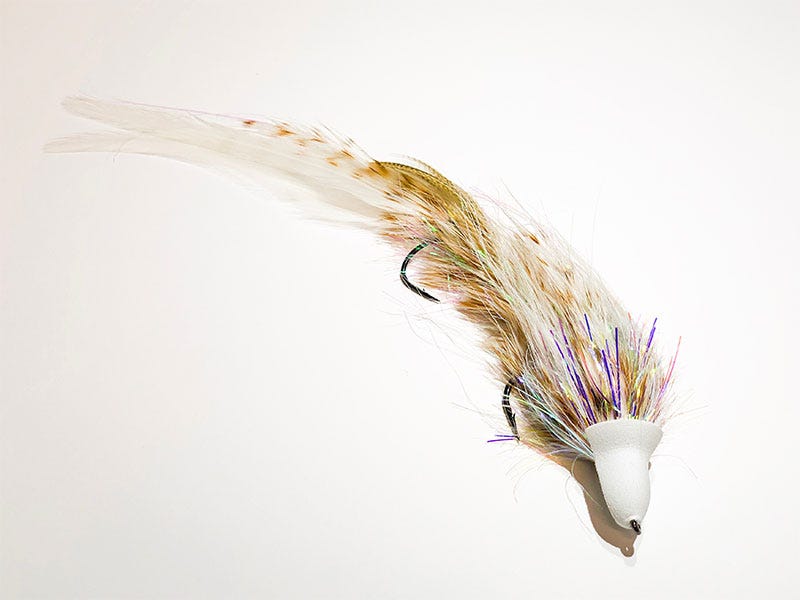
Schultz, “building off the original Swingin’ D, the 2.0 is an improvement to an already deadly design. The addition of shanks adds to the durability and increases the overall length/profile as well as gives the angler the ability to fish deeper. Depending on the weight of the keel, fly line used, and the size/shape of the head, this fly can be tuned to swim to depths up to five feet.
Schultz’s take on smallmouth flies gives us perspective into how we can continue to build upon our own patterns, constantly looking into what can be fixed to enhance the fly. Moreover, we don’t have to have a one-dimensional view on weighting systems for our flies.
Another thing that gets overlooked in fly tying is using permanent markers and paint markers to express color patterns of specific baitfish. Many patterns benefit from a like striping or darkening but some are virtually blank canvases.

When spending time back east fishing the Potomac and Shenandoah, we tied flies with stacked white EP fibers to make bluegill bodies and colored them to match the color phases of bluegills and juvenile smallmouth. One of the most popular flies in the warm-water scene that can be found in almost any fly shop around the nation is Chocklett’s game changer.
Even if you aren’t a serious tyer or are intimidated by multiple articulations, this fly in plain white is in its base platform. By using permanent markers, we can easily imitate our own choice of forage fish. Some may look down on turning your flies into a coloring book, but it’s an effective way to make a pattern pop. By adding different features to swim flies such as the game changer platform, we open up a world of possibility.
So, next time you sit at the vise, think about what flies you really want in your box. Adding your own flair to your favorite patterns can be the most rewarding aspect of fly tying. There are literally thousands of great smallmouth bass flies out there. Honorable mentions such as the Clouser minnow, Murdich’s minnow, and the half & half are other platforms that are easily tailored to the needs of the angler and his or her fishery.
Another aspect of fly design is spending time on the water and paying attention to what you see around you. Often times, we find ourselves taking pictures of things we see in the water that might aid us when we sit down on the vise. Pictures can be great fodder for fly ideas. Staying creative will help keep you motivated and avoid getting sucked into the tying doldrums of winter. The feeling of catching a fish on your own fly or a pattern that you tied is one that is hard to beat. After all, we can’t let ourselves get too caught up in what’s right and what’s wrong in the art of fly-tying. Let’s keep it fun and have a good time on the water.
